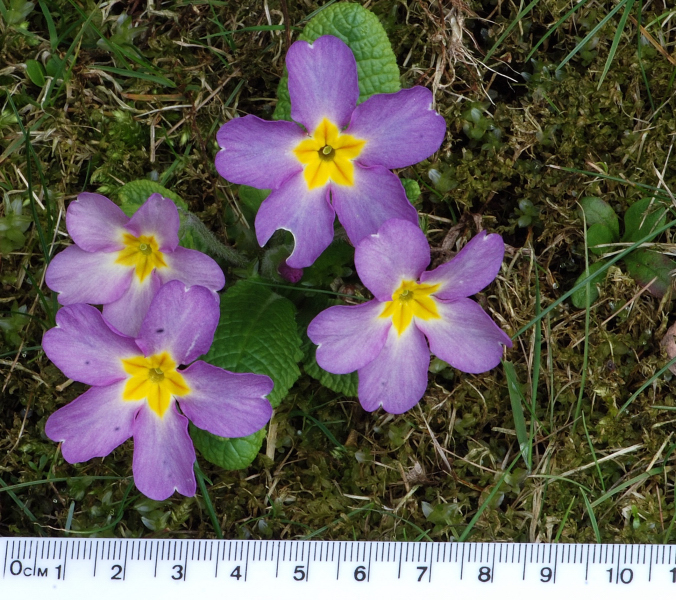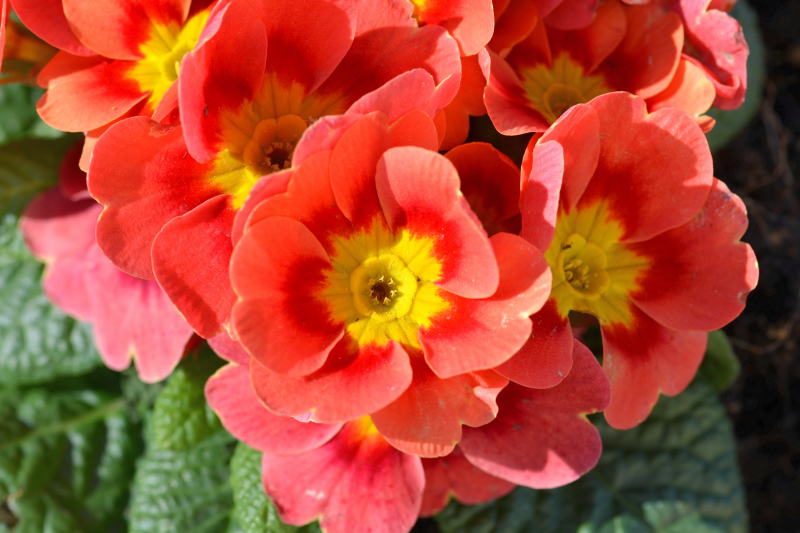As its name implies, primrose is a flower that emerges early after winter and colors the fields yellow, red and blue.

Primula veris belongs to the Primulaceae family, is widespread in Mediterranean and temperate countries, but is also found above 2500 meters.
Primula veris, commonly known as cowslip, is a perennial herbaceous plant belonging to the family Primulaceae. Native to Europe and parts of Asia, it is renowned for its bright yellow, bell-shaped flowers that appear in spring. The plant is valued for its ornamental appeal in gardens, as well as its medicinal uses, particularly in treating respiratory and nervous system ailments. Primula veris is also considered a symbol of spring in folklore.
Botanical Classification
- Kingdom: Plantae
- Clade: Angiosperms
- Class: Eudicots
- Order: Ericales
- Family: Primulaceae
- Genus: Primula
- Species: Primula veris
Plant Characteristics
Primula veris is a low-growing perennial plant with the following features:
- Height: Typically grows to a height of 10–30 cm.
- Leaves: Forms a rosette of wrinkled, oblong leaves with a slightly toothed margin. The leaves are light green and soft to the touch.
- Flowers: Produces clusters of bright yellow, nodding flowers with an orange spot at the base of each petal. The flowers are carried on a single stem that rises above the foliage.
- Roots: Thick, fibrous roots are used in traditional medicine.
- Growth Habitat: Thrives in grasslands, meadows, and open woodlands, preferring well-drained soils.
Chemical Composition and Structure
Primula veris contains several bioactive compounds that contribute to its medicinal properties:
- Saponins: Active compounds with expectorant and anti-inflammatory properties, particularly useful for respiratory conditions.
- Phenolic Acids: Such as rosmarinic acid, which exhibit antioxidant effects.
- Flavonoids: Including quercetin and kaempferol, which have anti-inflammatory and antimicrobial properties.
- Tannins: Contributing to the astringent properties of the plant.
- Vitamins: Rich in vitamin C, supporting immune health.
How to Cultivate Primula veris
Cultivating Primula veris is relatively easy in suitable environments:
- Climate: Prefers temperate climates with cool winters and moderate summers.
- Soil Requirements: Grows best in well-drained, fertile soils with a neutral to slightly acidic pH.
- Sunlight: Thrives in partial shade but can tolerate full sun in cooler climates.
- Watering: Requires consistent moisture but does not tolerate waterlogging. Mulching helps retain soil moisture.
- Propagation: Can be propagated by seeds, division, or root cuttings. Seeds are sown in autumn or spring, and mature plants can be divided in early spring or autumn.
- Maintenance: Minimal maintenance is required. Deadheading encourages prolonged blooming.
Uses and Benefits
Primula veris has a variety of uses, ranging from medicinal to ornamental:
Medicinal Uses:
- Respiratory Health: Saponins in the roots and flowers act as natural expectorants, helping to relieve coughs, bronchitis, and colds.
- Calming Effects: Traditionally used as a mild sedative to alleviate anxiety, insomnia, and nervousness.
- Anti-inflammatory: The plant's compounds are beneficial in reducing inflammation in the body.
- Digestive Aid: Historically used to treat mild digestive disorders, including bloating and indigestion.
Ornamental:
- Popular in gardens for its vibrant yellow flowers that herald spring.
- Often planted in rock gardens, borders, and wildflower meadows.
Culinary Uses:
- Flowers are sometimes used as a garnish or in salads.
- Young leaves can be cooked as greens or added to soups.
Applications
Medical:
- Commonly prepared as herbal teas, tinctures, or infusions for treating respiratory and nervous system ailments.
- Extracts from the plant are used in natural remedies and over-the-counter preparations for cough relief.
Cosmetic:
- Used in skincare products for its soothing and anti-inflammatory properties.
- Infusions of the flowers are sometimes used as a natural toner for sensitive skin.
Ornamental:
- Planted for its vibrant spring blooms, providing a splash of color to gardens and landscapes.
Environmental and Safety Considerations
Primula veris is a low-maintenance and environmentally friendly plant. However:
- Environmental Benefits: Contributes to biodiversity, attracting pollinators such as bees and butterflies. It is often included in wildflower seed mixes to enhance natural habitats.
- Safety: Generally safe for consumption and topical use, but individuals with allergies to plants in the Primulaceae family should exercise caution. Excessive consumption may cause mild gastrointestinal discomfort.
- Conservation: In some regions, Primula veris is protected due to habitat loss. Sustainable cultivation and planting in gardens can help preserve this species.
Many species of primroses, about 400, including :
- Primula auriculata
- Primula tibetica
- Primula undulifolia sp.nov. recently discovered in China
- Primula carolinella Hemsl with 12 subspecies
- Primula sinensis Sabine ex Lindley
- Primula poissonii
Studies
Medical
Primrose is an important medicinal plant with documented use for the treatment of gout, headaches, and migraines dating back to the Middle Ages. Triterpene saponins from roots and flowers are used in phytotherapeutic treatments against bronchitis and colds for their expectorant and secretolytic effects. Two flavonoids, six flavonoid glycosides, four new denatured flavonoid glycosides, five anthocyanins and three triterpene saponins have been identified in alcoholic extracts of petals, leaves and roots (1).
Traditional Medicine: Primula veris has been used in traditional European medicine (2) for various ailments, such as coughs, respiratory issues, and sleep disturbances.
Cosmetic Products: Due to its potential soothing and antioxidant properties, it can be found in lotions, creams, and other skincare products.
Herbal Teas: The leaves and flowers of primrose can be used to prepare herbal teas.
Properties
- Soothing: primrose is believed to have soothing properties that can help calm irritated skin.
- Antioxidant: It may contain antioxidants that help shield the skin from free radical damage.
- Expectorant: In traditional medicine, it's used as an expectorant to aid in coughs and respiratory conditions.
References_______________________________________________________________
(1) Apel L, Kammerer DR, Stintzing FC, Spring O. Comparative Metabolite Profiling of Triterpenoid Saponins and Flavonoids in Flower Color Mutations of Primula veris
Int J Mol Sci. 2017 Jan 13;18(1). pii: E153. doi: 10.3390/ijms18010153.
Abstract. Primula veris L. is an important medicinal plant with documented use for the treatment of gout, headache and migraine reaching back to the Middle Ages. Triterpenoid saponins from roots and flowers are used in up-to-date phytotherapeutic treatment of bronchitis and colds due to their expectorant and secretolytic effects. In addition to the wild type plants with yellow petals, a red variant and an intermediate orange form of Primula veris L. have recently been found in a natural habitat. The secondary metabolite profiles of roots, leaves and flowers of these rare variants were investigated and compared with the wild type metabolome. Two flavonoids, six flavonoid glycosides, four novel methylated flavonoid glycosides, five anthocyanins and three triterpenoid saponins were identified in alcoholic extracts from the petals, leaves and roots of the three variants by high performance liquid chromatography (HPLC)-diode array detection (DAD)/mass spectrometry (MSn) analyses. Anthocyanins were detected in the petals of the red and orange variety, but not in the wild type. No other effects on the metabolite profiles of the three varieties have been observed. The possibility is discussed that a regulatory step of the anthocyanin biosynthetic pathway may have been affected by mutation thus triggering color polymorphism in the petals.
(2) Graikou K, Mpishinioti A, Tsafantakis N, Maloupa E, Grigoriadou K, Chinou I. Comparative Phytochemical Analyses of Flowers from Primula veris subsp. veris Growing Wild and from Ex Situ Cultivation in Greece. Foods. 2023 Jul 6;12(13):2623. doi: 10.3390/foods12132623. PMID: 37444361; PMCID: PMC10341331.
Abstract. In the last decades, Primula veris subsp. veris (roots and flowers) has been over harvested through legal and illegal ways in Greece, due to its extremely high commercial demand, as it is used in industry because of its well-known therapeutic properties. As ex situ cultures of the plant have been already developed, in the current comparative study, the herbal teas (infusions) from both flowers of cowslip growing wild in the Prespa Lake Park (NW Greece), and from ex situ propagated and cultivated plant material, have been investigated, with the ultimate goal of assessing them qualitatively. Furthermore, through classic phytochemical studies, the ten most abundant metabolites, belonging to the chemical categories of flavonol-glycosides and methoxy flavones, have been identified and structurally determined. The chemical profile of both infusions has been further analyzed through UHPLC-HRMS, showing that they show only light differences. The total phenolic content (TPC) of both studied samples (wild and ex situ cultivation), was determined by the Folin-Ciocalteau method, followed by an antioxidant activity assay though DPPH where, in both cases, wild plants exerted higher phenolic load and stronger antioxidative properties. According to the reported results, it could be proposed that the ex situ cultivated plant material could facilitate the mass production of plants and the sustainable cultivation of cowslip in the Greek mountains.
![]() Primrose
Primrose 













